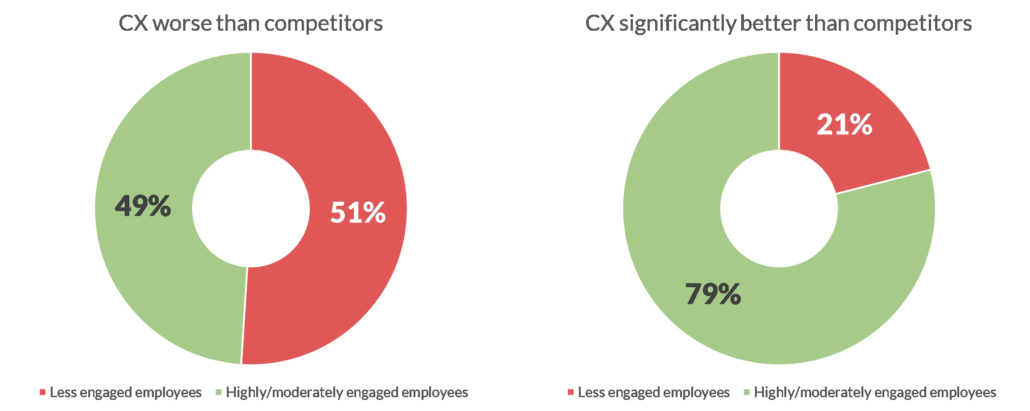
This quote reflects one of the biggest disconnects in customer experience – focusing only on the customer experience.
It makes sense. Why wouldn’t we?
But focusing only on the customer without regard to employee experience and satisfaction leads to missed opportunities and sub-optimized efforts.
I had the great honor to co-present on this topic with Darin Byrne, Wolters Kluwer’s VP of Client Experience. We made three primary arguments to our CX audience:
Let’s define employee engagement. Engaged employees:
We all want the discretionary effort – but it’s the first three that earn the right to ask for this extra focus. Unfortunately, we’re not doing so well at this.
The measurement of engagement varies somewhat by thought leader, which means the percentage of engaged employees varies. But most are similar to the Temkin Group’s estimate, which is that only 33% of employees are highly engaged. Worse, only 26% of those who are 18 to 24 years old are highly engaged.
Yet these are the people most likely to be servicing our customers, either in your call center or in other customer-facing roles. Until we can engage them, our customer experience will continue to suffer.
Temkin goes further to show this impact. When expanding the definition to include those who are either highly or moderately engaged, they find that companies with CX are worse than their competitors, about half (49%) are engaged. But at companies significantly better than competitors, that number increases to nearly 4 in 5 – 79%.

We can argue which way the causation arrow goes – do more-engaged employees create a superior customer experience, or do companies who focus on improved customer experience have better employee outcomes? – but the linkage is clear.
The retail space shows a similar linkage, as shown in this graph from Great Customer Experience Starts with the Right Corporate Culture, from Customer Relationship Management magazine.
It’s tough to be engaged when it’s hard just to get your work done. This is where user experience comes in – creating better employee tools supports your customer experience.
However, it appears that there’s still a ton of opportunity, as 59% of all workers are unhappy with their collaboration tools, as reported in Why Collaboration Tools are Crucial for Millennials in Business, Scalus.
When you zero in on Millennials, the figure gets worse, with 71% dissatisfied. Millennials have become accustomed to easy experiences – and most CRM, ERP, and other internal tools are anything but.
Outdated and inefficient systems, tools, and processes sap energy from employees, unnecessarily waste time, and make it difficult to serve the customer. Unintuitive systems require long onboarding time for training, keeping employees from doing the job they were hired for.
It’s definitely worth it to take the time to apply the same user experience principles you use for your customers on your internal tools.
Journey mapping is another useful tool for determining where problems are. We are receiving increased demand for employee journey mapping as a way to understand the points of friction in the internal experience.
Outside-in thinking is critical. But inside-out action creates the needed change. As Peter Drucker famously said, “Culture eats strategy for breakfast.” You can focus on creating a better customer experience. But until you get the employee experience right, it’s an uphill battle.
Unfortunately, our research has found that we in CX aren’t good at this area of focus. Despite the Temkin Group reporting that more CX professionals are focusing on Customer Centric Culture (74%) and Employee Communications and Engagement (69%) (see State of the CX Profession, 2018), our research in journey mapping found that 93% of the time, CX failed to invite HR to the project.
This, despite the fact that every customer experience project is a culture project.
Now, I get that some HR groups are more about compliance than culture change. But not 93% of them! If we don’t include HR, that means we’re missing a critical ally in the focus on culture.
A focus on company culture and the employee experience needs to be central to each CX leader’s plan. Partner with HR – but don’t outsource it. In my interviews with CX leaders, I find most don’t get involved with the employee engagement survey, preferring to let HR lead it. Yes, let them lead (and pay for) it. But get involved, so you can get the data right away and start planning action.
Creating a positive and engaging employee experience is more than just providing a comfortable workspace or competitive benefits. It’s about understanding and addressing the needs and expectations of your employees at every stage of their journey with your company.
In this discussion, I’ll walk you through the key stages of the employee experience from my personal perspective.
Here are the 5 stages of employee experience:
The employee experience begins even before someone is officially part of your team.
How your company’s brand is perceived, the ease and transparency of your application process, the responsiveness of your recruiters — all these factors create an initial impression that influences a candidate’s decision to join or not.
Once the employee joins, the onboarding process sets the tone for their experience. It’s important to make new hires feel welcomed, valued, and well-equipped for their role.
A well-structured onboarding plan can help new employees understand their responsibilities, integrate into the team, and familiarize themselves with the company culture and values.
Once an employee is established in their role, their ongoing growth and development become crucial.
Providing opportunities for upskilling, reskilling, or career advancement shows employees that you’re invested in their future.
Regular performance reviews, feedback sessions, and personalized development plans can be very effective in this stage.
Engaging employees is a continuous process. It involves fostering a supportive and inclusive culture, recognizing and rewarding good performance, and ensuring that employees feel their voices are heard.
Regular engagement surveys can provide valuable insights into what’s working and what areas need improvement.
Eventually, employees may leave, whether for retirement, a career change, or other reasons. It’s crucial to provide a smooth and respectful offboarding process, which can leave a lasting positive impression. Former employees can become valuable ambassadors for your brand, so maintaining a good relationship is beneficial.
Related Reading: Customer Journey Maps: The Top 10 Requirements
Darin wrapped up with his five tips for driving the Employee Experience through the Customer Experience program, which I’ve included here:
If HR isn’t doing it, can your CX program take the lead? Keep it simple, ask open-ended questions on a few key topic areas such as:
Ask what to:
Analyze and then (IMPORTANT) tell employees what you heard and what you are going to do. Then DO IT. Nothing improves employee engagement more than seeing feedback acted upon.
To gather this essential data, you can rely on various types of surveys. Here’s a look at several common types of employee experience surveys:
Employee Experience Surveys are designed to gather feedback from employees at various stages of their journey within an organization. These can be categorized as follows:
Recruitment experience surveys focus on a candidate’s experience during the recruitment and hiring process.
They may ask about:
Onboarding surveys aim to gauge a new employee’s experience during their introduction to the company.
They might cover the:
Pulse surveys are quick, frequent check-ins designed to take the ‘pulse’ of an organization’s employee experience in real time.
They can cover a broad range of topics and allow companies to identify issues and address them promptly.
Engagement surveys are comprehensive surveys conducted annually or bi-annually to measure how engaged and invested employees are in their work and the organization.
They often cover areas like:
These surveys collect comprehensive feedback on an employee’s performance from all angles:
This type of feedback can provide valuable insights into the individual’s work experience, performance, and opportunities for development.
Exit surveys are conducted when an employee is leaving the organization.
They provide insights into:
These surveys gauge employees’ experiences and perceptions related to diversity, equity, and inclusion within the organization.
They can help a company understand whether it is creating a truly inclusive and equitable environment for all employees.
Related Reading: Customer Journey Mapping Examples
Does your organization have a Guiding Principles document? What about a Strategic Framework or Mission Statement for the CX Program? If not, take the lead in getting them written and distributed. And discussed.
The core beliefs and objectives of an organization, encapsulated in its mission, vision, and values, play a vital role in shaping the employee experience.
Mission, vision, and value serve several key functions:
A clear mission provides a sense of purpose and direction for employees.
It helps them understand the organization’s objectives and how their individual work contributes to these goals. This alignment can result in a greater sense of fulfillment and motivation at work.
The organization’s values are integral in defining its culture. They shape the norms, behaviors, and expectations within the workplace.
A strong, positive culture can significantly enhance the employee experience, leading to increased engagement and productivity.
The mission and values can guide decision-making at all levels of the organization.
When employees have a clear understanding of these principles, they are better equipped to make decisions that align with the company’s goals and culture.
Shared vision and values can foster a sense of unity among employees, promoting teamwork and collaboration.
This sense of collective identity can enhance communication and coordination, both of which are crucial for a positive employee experience.
Clearly articulated mission, vision, and values can help attract and retain talent that resonates with the organization’s principles.
When employees feel a strong alignment with these, they are more likely to have higher job satisfaction and loyalty.
Help your senior execs see how CX information and success will engage employees, and get them talking about the customer in every communication:
Highlight employees doing the right thing. Package information for them to share. Set up some sort of internal social media – Yammer, for example, is a great way to connect employees.
Related Reading: The ADKAR Change Model and Customer Journey Maps
Use some of your CX budget to sponsor employee events – picnic, run/walk event, game tournaments, etc.
If one doesn’t exist. Enable employees to nominate others for great customer service, or just for being helpful and collaborative.
Provide a small immediate reward ($10 Amazon gift card) to the nominee and then have an employee committee choose the best each month for a larger award ($100).
Managers have a lot of reward levers, but putting a reward program in the hands of employees fosters great camaraderie and trust.
Improving the employee experience is a mission-critical task for any business, yet it comes with its share of challenges.
Having navigated these waters in my professional journey, I’d like to share some of the common obstacles you might encounter, and how to tackle them.
This is often the result of inadequate communication and insufficient attention to individual employee needs.
Organizations need to develop empathy by encouraging managers and leaders to actively listen to their employees. This can be achieved by implementing regular check-ins, team meetings, and anonymous feedback channels.
This way, employees will feel their voices are heard and their needs are addressed, fostering a more inclusive, understanding, and empathetic workplace.
Organizational silos can create barriers in communication, reduce knowledge sharing, and hinder collaboration. This leads to a disjointed employee experience.
To break down these silos, cultivate a culture of collaboration. This can be achieved by setting team goals, encouraging cross-departmental projects, and using collaborative tools and platforms.
The more your teams interact and understand each other’s roles, the better they can work together, enhancing the overall EX.
When leaders fail to understand the importance of EX, it can lead to insufficient investment and commitment in this area.
You can overcome this by presenting a compelling business case that links positive employee experience with improved business outcomes.
Showcasing concrete data and industry case studies can help convince leadership about the return on investment for EX initiatives.
When key messages aren’t delivered effectively, employees can feel left in the dark, leading to decreased engagement and productivity.
Building open and transparent communication channels is key to overcoming this. Regularly share company updates, involve employees in decision-making processes, and ensure that changes are communicated promptly and clearly.
Effective communication fosters trust and increases employee satisfaction and engagement.
Employees need to see a clear career path and growth opportunities to stay motivated.
Organizations should provide learning and development programs, mentoring, and opportunities for internal mobility. Regular performance reviews and career discussions can help employees understand their progress and identify areas for development, thus enhancing job satisfaction and retention.
When employees feel their efforts go unnoticed, it can lead to decreased motivation and engagement.
Foster a culture of recognition and appreciation. This could be through a formal rewards and recognition program, or through simple actions such as a thank you note or public acknowledgment in team meetings.
Recognizing employees’ efforts and contributions fosters a positive work environment and boosts morale.
Overworked employees can experience burnout, which affects their productivity, health, and overall EX.
Promote work-life balance by encouraging regular breaks, offering flexible work arrangements, and respecting employees’ time off. A healthy work-life balance leads to happier, more productive employees and can be a key factor in retaining top talent.
We’ve explored the importance of an effective employee experience strategy, the obstacles that may arise, and potential solutions to enhance your organization’s employee experience. Still, each organization and every employee’s journey within it is distinct. This individuality calls for a bespoke approach to address your specific needs and goals.
At Heart of the Customer, we’re devoted to partnering with you at every level of this journey, from identifying and fulfilling needs, tackling challenges, saving precious time, streamlining processes, and ultimately, elevating the quality of the customer and employee experience.
In today’s rapidly evolving business landscape, staying ahead with a robust employee experience strategy is not merely an option, but a necessity. Don’t let your strategy lag. Reach out to us at Heart of the Customer to begin charting your unique employee journey and take your employee experience to unprecedented heights.
Get in touch today!
Interested in CX workshops? Read more here.
Interested in journey mapping? Read more here.
Interested in improving your CX? Read more here.

